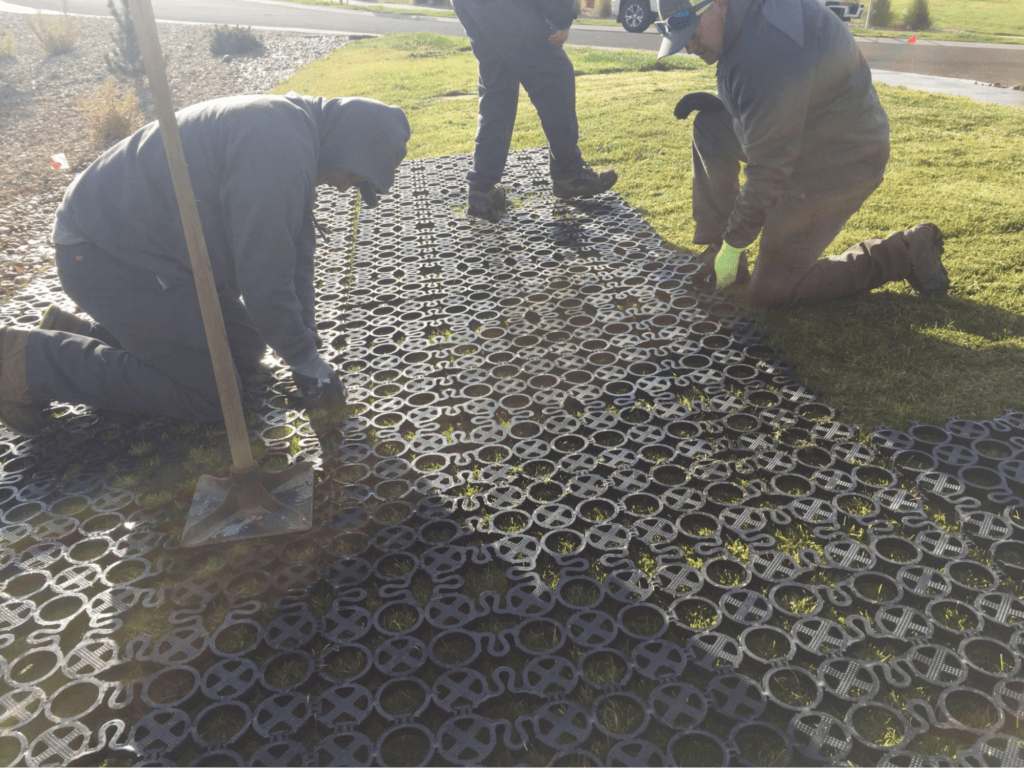
If traditional landscape fabric isn’t quite meeting your needs, or you would prefer to use a more natural and organic option, there are a wide variety of alternative landscaping fabric options to choose from.
What is Landscape Fabric?
Landscape fabric typically refers to a black or grey geotextile fabric that comes on a roll. This fabric prevents light from nourishing undesirable plant growth and prevents airborne seeds from infiltrating the fertile soil while still being porous enough to allow passage for air and water.
The two primary purposes for using landscape fabric are,
- Preventing weed growth
- Preventing soil erosion
How to Use Landscape Fabric

Using Landscape fabric can be a simple and effective measure in the battle against weeds and erosion.
- Place enough landscape fabric on top of your garden to effectively cover your entire planting area.
- Secure your fabric with stakes, staples, or other appropriate fasteners.
- Cut out holes where you plan on planting your starters and seedlings.
- Plant starters and seedlings in their corresponding holes.
How Does Landscape Fabric Work?
Landscape fabric prevents weed growth by physically preventing sunlight from reaching and nourishing unwanted plants. By only allowing the plants that you have specifically planted to penetrate the material, you should be able to eliminate most, if not all, weeds.
You can also use landscape fabric to help prevent erosion.
Landscape fabric is often secured over large embankments, near water, or across sloping grades to help reduce the amount of water saturated into the ground, potentially decreasing erosion.
Landscape Fabric Alternatives
Before we had the geotextile fabric we know today, gardeners, farmers, and other agriculturalists used many early organic landscape fabric alternatives to help prevent weeds from compromising their crops.
Cardboard
You probably have a stack of cardboard piling up in your garage, patiently waiting for you to take it to your local recycling center. Put that cardboard to work as a cheap landscape fabric alternative instead!
Although cardboard will not help prevent erosion, nor will it last you years of use, it can provide a formidable barrier to weeds and a delicious meal for worms as it decomposes.
Burlap
Burlap is the alternative landscape fabric most similar to the geotextile we often see today.
Although not as cheap as old cardboard, burlap can be significantly more affordable than modern landscape fabrics and an equally effective measure against weeds.
Installing it in multiple layers can protect your garden while also providing nutrients to the microorganisms in your soil as it decomposes.
Some people use burlap for temporary erosion control, but as it becomes saturated, it deteriorates, leaving the soil to run free once more.
Bark Mulch

Bark mulch is a terrific alternative to landscaping fabric and can be purchased affordably by the bag at most local hardware stores.
Bark mulch effectively retains moisture and helps to regulate soil temperature.
If you are considering using bark mulch, be sure it does not contain any dyes; these can harm the vital microorganisms in your soil.
You should also note that bark mulch can sometimes harbor common garden pests like slugs and snails, so keep an eye out!
Ground Cover Plants
Ground cover plants are just about the most organic and natural alternatives to landscape fabric possible.
These dense, low-to-the-ground plants effectively block weeds from receiving sunlight without interfering with your other plants.
The downside is that if you need to cover a large area, covering your garden in ground cover plants can get expensive quickly.
Using Permeable Pavers as Alternatives to Landscaping Fabric

Permeable pavers can be used as an alternative to landscaping fabric or, in addition to it, for an incredibly effective method of weed and erosion control.
Permeable pavers are plastic interlocking grids that can quickly be snapped together and secured in place by motivated homeowners and gardeners alike. Once connected, you can fill permeable pavers with gravel, grass, or mulch to create weed control that won’t spill out of your well-kept garden.
Design Resilient, Stunning, and Eco-Friendly Outdoor Spaces with TRUEGRID
Whether you’re looking to create beautiful gardens, grass driveways that won’t die or develop ruts, or industrial-grade gravel parking lots that don’t kick up dust, TRUEGRID has exactly what you need.
TRUEGRID has been manufacturing its full line of alternative paving products from 100% post-consumer recycled HDPE right here in the U.S. since 2013.
Since its inception, TRUEGRID has prevented millions of pounds of plastics from entering our landfills and waterways while returning millions of gallons of stormwater to vital groundwater supplies.
Learn more about the full line of TRUEGRID products, or get an estimate today and discover how you can be true to your project and true to the environment with TRUEGRID.



